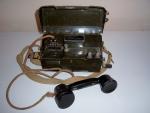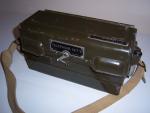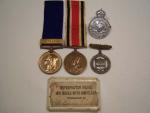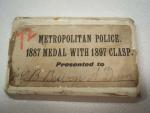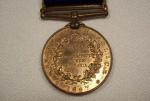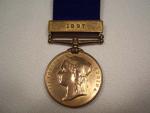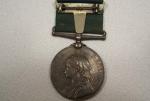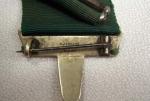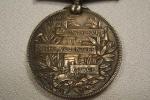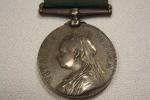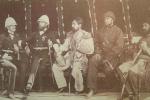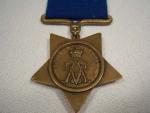-
Posts
6,486 -
Joined
-
Last visited
-
Days Won
10
Content Type
Profiles
Forums
Blogs
Gallery
Events
Store
Everything posted by Brian Wolfe
-
Thanks for that information Alan. Since this officer was serving during the Great War as a Special Constable I think it quite likely that he would have still been serving into the 1920's. Also, as you have pointed out, being an ex-P.C. he would have more than likely risen in the ranks thereby qualifying for the chromed cap badge. Thanks again for the additional information. Regards Brian
-

Field Telepnone "L"
Brian Wolfe replied to Brian Wolfe's topic in Great Britain: Militaria: Badges, Uniforms & Equipment
Many thanks IrishGunner. I suspected they were used during the Korean War but was not sure. Regards Brian -

Field Telepnone "L"
Brian Wolfe replied to Brian Wolfe's topic in Great Britain: Militaria: Badges, Uniforms & Equipment
Here's a better view of the hand set and the wire damage that occurred as the wire was caught between the lid and the case as it was closed. I hope you like my latest offering from this obscure branch of military collecting. Regards Brian -

Field Telepnone "L"
Brian Wolfe replied to Brian Wolfe's topic in Great Britain: Militaria: Badges, Uniforms & Equipment
This view is with the case lid open. The rectangular section between the mouth piece and the ear piece of the hand set is where the two "D" sized batteries are inserted. The wires in the area, to the right of the hand set, where the wire would meet the lid as it closes is a place where a lot of damage to the handset wires occurred. -
Hello Everyone, Here's another offering from my limited collection of field communications equipment. In this case it is the Telephone type "L" as used in WWII and for some time afterwards. I can't find much information regarding these other than they were used during WWII by the allies, this one being Canadian, but for how long afterwards I do not know. Perhaps some of the members can assist me with that information? These operated through wires connected back to a receiver. There is a crank on the side to "ring up: the other end and the phone runs on two "D" batteries. Regards Brian
-
Here's a grouping that was awarded to P.C. B (Bernard) Bowen, A Division of the Metropolitan Police. The 1887 Police Jubilee Medal with the 1897 Clasp came with the original box top addressed to P.C. Bowen. This begs the question that, if the recipients of the 1887 Jubilee Medal only received the 1897 Clasp, provided they qualified, then why is it that P.C. Bowen received this medal complete with Clasp after 1897. I say "after" because he would have had to have been on duty at one of the parades etc. to have qualified. I've posted the medal with this question on the Commonwealth Police thread as well to see if any of our members there or here can answer this question. The grouping came with the "National" Special Constabulary Long Service and Good Conduct Medal named to Bernard Bowen as well as the Metropolitian SC Long Service broach-style Medal 1914, and a cap badge for the Met's Specials. The cap badge has two loops for attachemnt to the cap and ,I believe, is not a lapel badge. Whether the cap badge and the Metropolitian Medal were awarded to SC Bernard Bowen is not above question. however, I think it is likely his. Any of the members thoughts and opinions are, as always, welcomed and appreciated. Regads Brian
-
Here is the box lid and as can be seen this seems to be a common enough label and not a hand-written "one-off". This would seem to make the Medal Yearbook less than accurate as it appears the 1887 Medal was still being issued with the new 1897 Clasp attached to those who qualified. Would that mean P.C. Bowen might very well have had the 1887 Medal in his position and then received the modifcation after 1897? Regards Brian
-
Hello Everyone, I have aa 1887 Jubilee Police Medal with a 1897 clasp in a group that includes a Special Constablary Long Service and Good Conduct Medal both named to the same officer. I will be posting this pair with the grouping of items that came with it under the thread dealing with the Special Constabulary later on. This medal was awarded to: P.C. B.(Bernard) Bowen, A Divn., of the Metropolitan Police. Here is my question, The "Medal Yearbook", 2004, published by Token Publishing, states under reference number 294. Jubilee (Police) Medal 1887: "Issued to all ranks of the Metropolitan and City of London Police involved in the parades and celebrations on 21 June 1887." Further to this they state, - and this is the important part -," Clasps for the 1897 were likewise issued ten years later". On the next page under reference number 297. Jubilee (Police) Medal 1897, they state, "Very similar to the 1887 issue with the dates suitably amended and the name of the service round the top of the reverse." Then, - the other important point -, "Holders of the previous medal [1887] merely received the 1897 clasp". The medal I have also came with the original box with the recipient's name written on the cover. The box is marked, "Metropolitan Police. 1887 Medal with 1897 Clasp". The Medal Yearbook writeup would make me think that any recipients of the 1887 Medal would have only received the 1897 Clasp. Yet here is obviously a 1887 Medal that was sent to the recipient after 1897 complete with the Clasp for 1897. I find it interesting that P.C. Bowen would recieve the 1887 medal complete with 1897 Clasp rather than simply receiving the 1897 Clasp. Have any other members found this to also be the case for medals in their collections? Regards Brian
-
I too looked through the forum and found nothing. I am sure I have posted Red Cross somewhere but where I cannot say now. Since this section is specifically for your collection if you would like to start a post in another area others could add to it. I've done a similar thing in the section under Commonwealth Police for Special Constabulary memorabilia. I will be glad to add my modest collection of Red Cross items - mostly WWI - to that post. Regards Brian
-
Oops, I just realized what section this is posted in. Sorry, this area is for collectors to post THEIR collections and not for general discussions. I would have deleted my post but I think the point is still valid even though I "carelessly" placed it in the wrong section. My apologies. Regards Brian
-
Hi Muckaroon, Thanks for posting you interesting collection. I have just a couple of comments, or rather a comment and a suggestion in general. First, while the Red Cross may not be military in the strictest sense of the term I think they have proven their "right" to be displayed on the GMIC. So please continue to do so as it is a very interesting area of study. I believe we had - or had - a member who collected Red Cross memorabilia, though I don't remember seeing any current posts from him. So if he is reading this post please join in, I apologize that I have forgotten your name. Getting old is not all that...what was I saying? Second,as a general comment, I hope other Red Cross collectors or those of us who have Red Cross items in our collections will add to this thread, with Muckaroon's permission of course. I think it is important to build threads into a reference source and the best way - in my less than humble opinion - is to build a thread into such a reference source through membership participation. My grand daughters are coming for a visit later today so I'll be busy spoiling them rotten; however, I will, with your permission Muckaroon, post some of my Red Cross collection on this thread later. Great thread and thanks for posting your collection. Regards Brian
-
Hi Kevin, I think it would be great if you would post these comic post cards here. You are so spot on in that they demonstrate the British capacity for humour during he darkest of times. It would be nice if everything to do with the Special Constabulary could be kept in this one aera. At times you have to search all through the forum to find the information on a particular subject; so it would, or I should say could, be avoided for the Special's collector if we were to keep it together. I'm looking forward to viewing your collection of post cards. Regards Brian
-
I'm not sure as to which, if any, regiments in Ontario were lancers. We have a couple of members who would probably know this, Peter and Michael come to mind straight off. Any photographs or detailed drawings I've seen seems to suggest that lance points were longer, more dagger-shaped. It's too bad there are no markings as that would clear everything up in a second. Regards Brian
-
Hi Leigh, Thanks for posting this photo. Up until now I've never actually seen proof that this occurred, though I knew to did. As I said earlier it would appear that the medal I posted is of the swivel style, however, I believe it was seized from the date of manufacture. It's not something I would argue - and how could I not having been there when it was awarded? - but your photo would suggest that it could have been worn with the reverse side exposed. It's one of those mysteries that will have to go unanswered. Thanks for posting the photo, that is a very nice group of medals regardless of how they were mounted. Regards Brian
-
Hi Kevin, These are great documents that give such an insight into the duties of the Special Constabulary during the War Years. Up until now that closest things I've seen by way of a document chronicling the duties of the Specials are those comic post cards you see for sale dating from that period. I am joking of course, however, it is great to see these documents and I thank you very much for posting them for all to see. Regards Brian
-
The suspension would, upon closer inspection, indeed look to be of the swivelling type. However, it seems to have been "jamed" tight as if when it was produced the top of the pin that was struck to prevent the hanger from coming apart was done so with too much pressure. When I posted this medal I thought it was of one piece as it is so tight; being no movement what-so-ever. If the damage to this part happened after it was awarded, which I now suspect was the case, it clears up that mystery. Many thanks for your answer to my question, Tony. Regards Brian
-
This is the medal as it would appear with the obverse showing the rear and the hanger in the position for wear. So the medal would have to have been worn with the obverse next to the uniform or jacket with the "Long Service in the Volunteer Force" showing to the public. As you can see this medal is in excellent condition so it was probably kept tucked away until it went to market many years after it had been awarded. I do believe this is the original ribbon as well. I display it with the obverse showing and the hanger's "arm" simply pointing straight up. Regards Brian
-
This is a view of the hanger's maker's stamp. Over the years the loop that holds the tip of the pin has been bent fully closed so opening the pin is not possible withoout bending the loop out into the "C" shape that would have been original. I can't see doing so and taking a risk in breaking the loop just for the photo.
-
Hello Everyone, Here's a Volunteer Long Service and Good Conduct Medal (1884 to 1901) that has been mounted such that the reverse is shown in wear. These medals were awareded for 20 years of service in the ranks, though officers could also receive the medal, being eligible on account of their non-commissioned service (from Medal Yearbook 2004,published by Medal News). The ribbon is plane green and this one is unnamed. From the writeup in the Medal Yearbook it would seem these were issued unnamed. If any of the members know if these were issued named please let us know. The medal was instituted in 1894 and this one would have to have been awarded within the reign of Queen Victoria between 1894 and 1901 due to the use of the "old head"(1893 to 1901) on the medal. These meals were superseded by the Territorial Efficiency Medal in 1908 although they were awarded until 1930 in Burma, India, Isle of Man (Isle of Man Vol.) and the 7th Volunteer Battalion of the King's (Liverpool) Regiment. The hanger is marked H.JENKINS & SONS BIRMh. The hanger has been installed so that the reverse would be showning in wear. Considering the condition of the medal I doubt it was ever worn so this would not have become an issue. This is not the first time I've seen medals put up the wrong way 'round and I have often wondered if these were ever actually worn in that manner. I doubt they would have been tolerated on the Parade Ground but once retired from service would they have appeared in public "backwards"? I would really like to hear what the membership has to say regarding this question, as always your input is valued. Regards Brian
-
Many thanks, Kevin. There are a good number of members, me included, who would rather respond to a real name rather than an internet name. It is much more friendly. Looking forward to more posts, the ones you have posted are most informative and have given us an insight that is not commonly available. Regards Brian
-
AS I was putting everything back in the file after the above post I came onto this photo. The copyright has expired and it is now in the public domaine so it should be alright to post it here. The photo is of Mohammad Yaqub Khan (centre) with Major Cavagnari, C.S.I. to his right and then Mr. Jenkyns. To Yaqub Khan's left is seated Daoud Shah and Habibulla Moustafi. This was taken in May 1879 by John Burke at Gandmak, Afghanistan. Regards Brian
-

My Khedive's Star Collection
Brian Wolfe replied to Brian Wolfe's topic in Great Britain: Orders, Gallantry, Campaign Medals
Here is the reverse. The medal was awarded to: PTE. VEERA GOO, Q.O.S&M (Queen's Own Sappers and Miners) Brian



